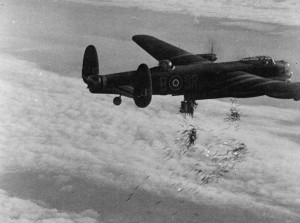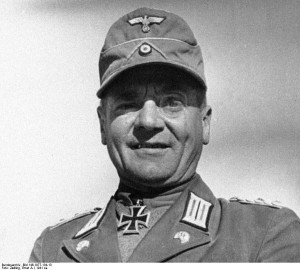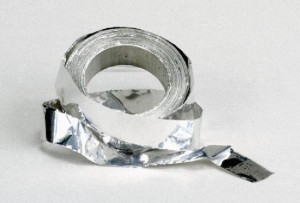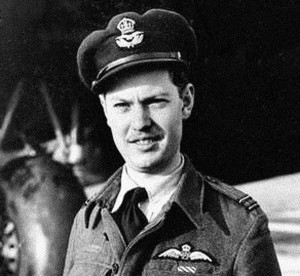Published on June 6, 2013
By Thomas Van Hare
In the early morning hours of D-Day, on June 6, 1944, a huge Allied invasion force was moving toward Normandy Beach on the northern coast of France. The fortifications of the Atlantic Wall, erected by the Germans, were massive and provided a huge advantage in the immediate defense against the Allied attack. The Atlantic Wall alone, however, would not be enough to stop an invasion — rather, it would only slow the advance and hold them on the beach until armored units held in reserve could be moved to engage. Thus, the key to victory for the Allies was based on a deception designed to keep the armored reserve occupied elsewhere or delayed in arriving until a strong beachhead could be established. If not, then the Allies could be thrown back into the sea.
A series of deception plans were designed to support the invasion. The key goal was to mislead the German high command about the real location of the invasion itself. In all, five plans were used in the overall deception — two pointed to possible invasions along France’s Mediterranean beaches, one on the west Atlantic coast, one to the Balkans (!) and the final one focused to the east, at Pas de Calais. This last one the key to the operation and the effort had gone on for many months leading up to D-Day with fake, “inflatable armies” of dummy tanks and trucks, fake fuel depots, entire camps of soldiers that were unoccupied, and even fake ships in the harbors along England’s southeast coastline. Everything was designed to show a massive invasion at the narrowest point of the English Channel, between Dover and Calais.
WATCH THE VIDEO
On the morning of D-Day, however, all of these efforts would come to naught if the Germans didn’t actually see an invasion fleet on the way at Calais. After long thought, therefore, the British took on the task of simulating the approach of thousands of ships, projecting on multiple German radar screens, showing the invasion approaching as if chugging along at 8 knots. Without that final ruse, it would be easy for the German high command to determine the real story and quickly position their reserve armor forces westward to Normandy, with likely fatal results to the Allied invasion plan. Yet the question plagued the British planners — how to simulate an invasion fleet of ships? After long thought, it seemed the best option was to do it with airplanes even if none could fly as slow as 8 knots speed, of course. A different, more creative solution would have to be found — and the planners within Bomber Command had just the trick up their sleeve to make it work.

Fortitude South
The full range and extent of Operation Fortitude South was vast and involved all military services from all of the Allied nations. If the ruse of a landing at Calais was to be believable, all of the necessary preparations would have to be visible. A large build-up would have to be demonstrated at Kent and all along the southeastern coast of England. Ground forces were mimicked with inflatable tanks, complete bivouacs, troop concentrations with tents (all empty), vehicles parked along roads. A fake invasion fleet of ships in the harbors was built of wood and canvas. Airfields were mocked up with inflatable and wooden planes laid out on the grass. Oil storage depots and ammunition supply dumps were built, all empty buildings and fake oil tanks. Other areas were camouflaged with netting to give the impression that something was hidden — yet nothing was there.
To ensure the Germans could detect the deception of the fake build-up, by plan Allied aerial interceptions of Luftwaffe reconnaissance planes were minimized. This gave the Germans sufficient photos to interpret — though always not enough to spot that the equipment and troops were all fake. Double agents were used to provide false data, all of it carefully validated from multiple reports and sources to provide intelligence confirmation of various tidbits and details. The occasional report of the truth, thus, was masked because the overwhelming number of reports supported the build-up of Fortitude South’s deception play. Even radio traffic was spoofed, clogging the airways with routine message traffic that originated throughout Kent.

Another strategy involved using a German general, Oberst Hans Cramer, who had been captured in North Africa. With good timing, he was repatriated to Germany (through neutral Sweden) when he fell severely ill while being held as a POW. To support the deception, the German general was driven through the actual areas of invasion’s real build-up. He was given something of a grand tour during his trip home, while being told he was in Kent. Subtle comments and “accidental slips” were made while on the road, while a few signs were changed along the route (if only for a few hours). What the general didn’t know, however, was that he was not in Kent at all! What he saw was ground evidence of the massive build-up, recognizable as real tanks, real troops, and everything he would expect to see.
Predictably, once back in Germany, General Kramer reported what he had seen throughout “Kent” and the Nazis had their confirmation. To fake such a huge build-up was impossible, the intelligence officers reasoned and his reports provided their final confirmation that Kent was awash in troops, weapons, tanks, supplies, depots, trucks and more. The aerial photographs continued to confirm beyond a reasonable doubt that the tanks, planes, supplies, ships, troops and landing craft were all massing in Kent — the largest ground force ever assembled. Based on that, the Germans concluded that the invasion was destined to land at Calais. Above all, Hitler and his top generals held no personal doubts on the matter and thus, it was hoped, once the actual invasion was underway in the early morning hours, they would delay shifting the armored reserve westward to Normandy, despite what would be an overwhelming number of reports of the actual invasion from the defenders along the Atlantic Wall.
A WINDOW of Deception
The final deception of Operation Fortitude South would be the crowning achievement of the deception campaign. It was accomplished with the faked advance of the invasion fleet itself on the morning of June 6, 1944 — 69 years ago today in aviation history. Since every ship was needed for the real landings, the fake invasion fleet would be mimicked with aircraft instead. To do this, a carefully scheduled set of aerial missions were ordered to be flown during the early morning hours of D-Day.
The key to the ruse was the use of WINDOW, tiny and long rolls of strips of tinfoil that unwound when dropped from Bomber Command’s bomber fleet. During night missions over Germany, WINDOW blocked radar signals by reflecting the beams back in huge brightly lit areas, thus obscuring the bombers in the bomber stream. Now for Fortitude South, Bomber Command ordered a fleet of Avro Lancaster and Short Stirling Mk.III bombers, each carrying huge quantities of WINDOW, to fly at low altitude (3,000 feet over the waves) in long orbits east to west. The planes would fly in trail of one another along a pair of lines that roughly defined two fleets approaching in the offshore waters between Boulogne and Le Havre.

To simulate the slow advance of the fake invasion fleet, each orbit was flown so that the southern long leg advanced from England slightly toward the beaches of Calais as the aircraft flew in a continuous stream. The planes would drop WINDOW as they traced long racetrack orbits over the English Channel. The planned spacing between each plane ensured that no gaps developed in the radar reflection caused by the slowly descending WINDOW tin foil strips. Each orbit was planned to show a radar picture of a pair of large invasion fleets steaming toward France at a steady 8 knots of simulated speed. Two small groups of ships supplemented the operation with balloons that were designed to reflect the signals as well.
However, in the months leading up to D-Day, the planners of the WINDOW mission realized that, while it looked simple enough on first thought, the task was unexpectedly complex. As the Lancasters and Stirlings could only carry a limited amount of WINDOW bundles (even if that was a lot each since they were not carrying any bombs), they couldn’t stay on station long before running out. Each aircraft would have to fly a preset number of orbits, dropping bundles at closely timed intervals before checking out of the orbiting bomber stream and returning to their bases. In perfect sequence, each departing plane would need to be replaced by another aircraft, scheduled to arrive into the orbiting stream at precisely planned timings. There was no other way to achieve the desired result. If a plane or two was late, gaps would develop in the radar signature of the fake “invasion fleet”. Yet as complex as the flight planning was, it could not be practiced due to the secrecy of the operation.

In the end, the problem was solved by scheduling more planes than necessary to achieve redundancy of the reflective WINDOW drops. Despite the added challenges of that scheduling, the mission worked perfectly. As it happened, the pilots hated the mission, having little idea of just how important their task was. For them, it made more sense to fly a deep penetration mission against Germany to bomb Berlin. One pilot, S/Ldr Dave Shannon, an Australian and one of the famed “Dambusters” of RAF 617 Squadron, described it in his logbook as follows: “Involved the hazardous task of flying straight and level at 3,000 feet in bright moonlight and dropping Window at the same time. (Bloody browned off).”
An excellent summary of the full operation can be found in a paper prepared in 2002 by Lieutenant Colonel Michael J. Donovan, USMC, for the US Army War College. It also describes some of the other aerial deception programs put into play that day:
While many of FORTITUDE-SOUTH deceptions had been going on for months, some had been designed and saved for use on D-Day in direct support of the NEPTUNE landings. Operations GLIMMER and TAXABLE utilized balloon mounted MOONSHINE equipment. These balloons were then in turn mounted to ships and barges rigged for towing. In the early morning hours of 6 June these two ghost assault forces made their way towards the French coast. GLIMMER actually consisted of eight boats and headed towards Boulogne while TAXABLE consisted of six boats bound for Cap d’Antifer. In addition to the MOONSHINE being towed by the two ghost fleets, WINDOW (chaff) was dropped overhead of both flotillas. The combination of the chaff and MOONSHINE radar repeater/amplifiers gave the appearance to the operators of the few remaining German coastal radar sites of two large fleets moving with air cover to the Pas de Calais area. WINDOW clouds also were used to create the illusion of large bomber formations headed to Germany to draw fighters away from the Allied gliders and transports headed to Normandy. Just before dawn additional aircraft were brought in to lay down a heavy smoke screen between the ghost fleets and the shore.
The Impact of the Deception
Even as early news came in from German intelligence units of the first overnight Allied airborne assault along the coastline of Normandy, Hitler and his senior generals still believed that Normandy was just a feint, designed to make them draw off their armored reserve toward Normandy before the real attack at Calais came. The successes reported at some points along the beaches in Normandy further reinforced the feeling that the attack there was a smaller one, ill-supplied and serving as a sacrificial mission. The real attack they decided was yet to come at Calais. Radar reports confirmed the large fleet approaching there, even confirming that it was slowly approaching and scheduled to arrive in mid-morning. As dawn broke, smoke screens obscured the horizon over the sea. Meanwhile, the main landing had begun along the four main beaches at Normandy, far to the west — GOLD, SWORD, UTAH and OMAHA. Yet still, the Germans held off the commitment of their reserve forces as the defenders at Calais readied themselves for what they believed was the real attack.

Only one unit — the 21st Panzer Division — was in the Normandy area. It was a powerful unit, however, and even this one unit created a serious risk to the landing. As the situation worsened on the Allied side with the near failure of the landings at Omaha Beach (General Omar Bradley even made a request to withdrew, but the message was somehow lost in the radio traffic and was not seen by General Eisenhower until later in the day), that danger magnified. Victory and loss were hanging in the balance. If committed to the battle, the Panzers would have likely driven the Allied invasion forces back into the sea. Yet the order to attack was delayed, though for reasons that had nothing to do with Fortitude South.
As the morning hours wore on, the Germans continued to await the arrival of the vast fleet that their radar stations showed approaching at a steady 8 knots of speeds. In fact, all but the 21st Panzer Division remained focused at Calais, and even that sat idly by for the most critical hours of the invasion. This left the defense of Normandy to the regular forces stations there. The deception was so complete that even when the commanders realized they’d been tricked and demanded immediate reinforcements in the Normandy area, Hitler refused to allow any to be sent. He was the last one to believe in what is likely the greatest military ruse in the history of military warfare.

As for the 21st Panzer Division, that is another story and one of a fortuitous bit of luck on the part of the Allies. By the time that powerful unit was committed to the battle, it was too late to stop the invasion. The golden opportunity had been missed as the beachheads had been secured. Soon afterward, Allied forces were starting to move inland and massive landings of supplies began to stack up on the beaches as well as more troops arriving in subsequent waves.
One can only imagine the wonder on the faces of the radar station operators at Calais when the vaunted fleet that they had been watching through the night and into the morning simply disappeared as the last of the WINDOW strips fell into the water and the last orbiting Lancaster planes flew home. The final deception of Operation Fortitude South was one of the most important bomber missions of the war, though not a single bomb was dropped.
One More Bit of History
While it doesn’t concern any aircraft or pilots, the story of why the 21st Panzer Division was late in committing to the battle is an interesting one. It also shows that you can never predict anything in either love or war. That story involves the commander of the 21st Panzer Division and his German actress mistress in Paris. With the bad weather, the Germans had felt that the invasion would be delayed. Many commanders had gone to Rouen for an exercise to practice invasion response tactics. Rommel, the famed Desert Fox, had been in change of the defenses, and he had gone home to Germany to celebrate his 50th birthday with his wife — another lucky coincidence.
As for the 21st Panzer Division commander, Generalmajor Edgar Feuchtinger, his reason for visiting Paris had to do with his girlfriend, an actress he brought over from Hamburg, Germany. He took the opportunity to make a nighttime visit with her as was often his practice. As a result, he was late returning to his unit on the morning of June 6, moving to Caen, but with his girlfriend coming along for company.
On his arrival that morning, finding that orders to deploy the 21st Panzer Division into the fray from Berlin had not yet been heard, he nonetheless made the correct military decision and issued the order himself unilaterally, though by then it was already 7:40 am. Had he not gone to Paris, he would probably have mobilized his unit around 2:00 am, nearly five hours earlier — a critical period in the landings. It was late in the morning when the 21st Panzer Division was organized to move and the unit rolled only at 10:45 am, heading to a point between Caen and Bayeux in hopes of stopping the British advance inland. As a result of these delays, the first major engagement for the 21st Panzer Division took place only late in the day at 16:15 at Périers Ridge where it came up against the British 185th Brigade, which had landed much earlier that morning at SWORD Beach.
For much of the battle, Generalmajor Feuchtinger commanded from the rear in the company of his girlfriend, so to speak. Whether he would have been anything but a bad combat commander is not much in debate — in fact, his sole claim to fame in the German military command was that he had been a rally organizer in Hitler’s inner circle before the war. He had never in his life seen combat nor commanded a military unit prior to his appointment over the 21st Panzer Division.
As for his actress girlfriend, she should have gotten a medal for her role that night and in the days thereafter for helping to delay the arrival of the 21st Panzer Division’s commander and later keeping him “occupied”. Unknowingly, she saved thousands of lives and quite likely saved the invasion from turning into a disastrous rout. One can only imagine what might have happened at OMAHA Beach had the 21st Panzer Division stormed onto the heights and opened fire.
Indeed, as many say, God works in mysterious ways.
